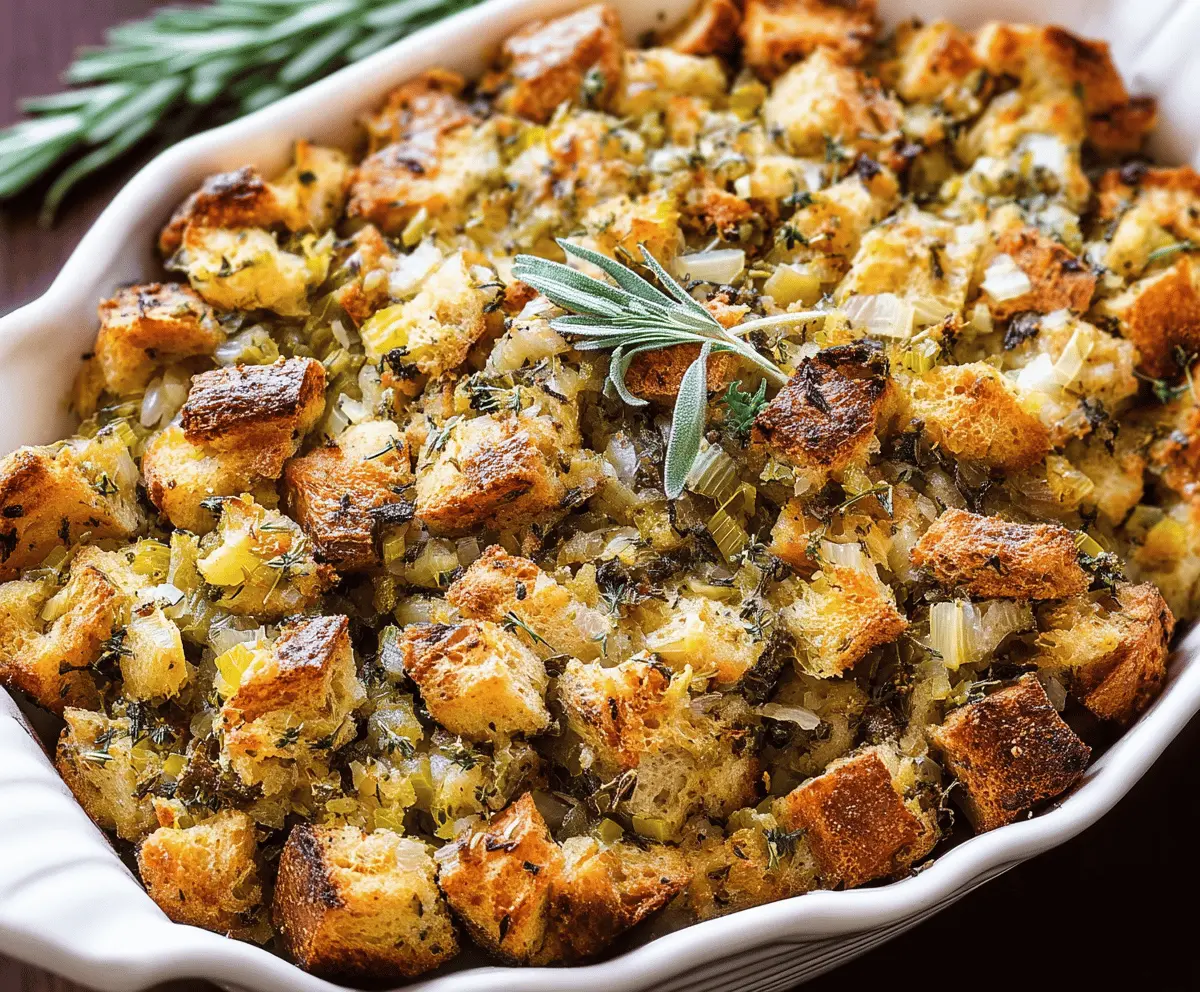Stuffing Recipe Thanksgiving is a classic dish that brings warm, comforting flavors to your holiday table. It’s full of soft bread cubes, savory herbs like sage and thyme, and often mixed with sautéed onions, celery, and sometimes sausage or nuts for extra texture. The combination is simple but so satisfying, making it a must-have for any Thanksgiving meal.
I love this stuffing because it’s easy to make ahead and fills the house with such a wonderful aroma that instantly feels like the holidays. I usually toast the bread cubes the day before to get the perfect texture, and I always make sure to taste it as I go—sometimes it needs a little more salt or fresh herbs to really come alive for me. It’s one of those dishes that feels like a hug in food form.
My favorite way to serve this stuffing is right out of the oven, golden and slightly crispy on top but soft and flavorful inside. You can spoon it beside your turkey or even stuff it inside if you want to keep things traditional. Either way, it’s a crowd-pleaser that brings family and friends together around the table, sharing stories and smiles. This recipe is a sure way to make your Thanksgiving extra special year after year.
Key Ingredients & Substitutions
Bread: Rustic white or sourdough bread works best because it has a sturdy texture that soaks up broth without falling apart. If you don’t have these, a good Italian or French bread is okay. Avoid soft sandwich bread to keep it from turning mushy.
Butter: Unsalted butter lets you control the saltiness. You can substitute with olive oil for a dairy-free version, but the flavor will be a bit different—still tasty though!
Herbs: Fresh sage and thyme add classic Thanksgiving flavor. If you only have dried, reduce the amounts to about one-third the fresh amount since dried herbs are more concentrated. Fresh parsley brightens the dish but can be left out if needed.
Broth: Low-sodium chicken broth is great for moisture and flavor. Use vegetable broth for a vegetarian option. Adjust the amount slowly to keep the stuffing moist but not soggy.
Eggs: Eggs help bind the stuffing so it holds its shape when baked. For an egg-free version, you can try a flaxseed “egg” (1 tbsp flaxseed meal + 3 tbsp water) but the texture may be looser.
How Can You Get the Perfect Texture for Your Stuffing?
The texture of your stuffing is key—it should be soft but with crispy bits on top. Here’s how:
- Dry the bread well: Toast or air-dry the bread cubes overnight to get the right dryness. This helps them soak up the broth just right without turning mushy.
- Cook veggies slowly: Sauté onions and celery until soft and translucent. This builds flavor and keeps veggies tender.
- Add broth gradually: Pour in broth little by little and toss gently, so the bread soaks evenly. Stop before it feels soggy.
- Bake covered first: Covering keeps moisture in so the stuffing cooks through without drying out.
- Crisp the top: Uncover the last 15–20 minutes of baking to encourage a golden, crunchy crust that adds great texture.
Following these tips will help you make stuffing that’s moist inside with a lovely crust on top—just like the classic Thanksgiving you remember.

Equipment You’ll Need
- Large skillet – perfect for sautéing onions, celery, and garlic evenly without crowding.
- Sharp knife – helps you chop vegetables and herbs finely for even flavor distribution.
- Cutting board – gives you a clean, sturdy space to prep your ingredients safely.
- Mixing bowl – big enough to toss bread cubes with veggies and broth comfortably.
- 9×13-inch baking dish – roomy for the stuffing to bake evenly and develop that crispy top.
- Aluminum foil – used to cover the dish while baking to keep the stuffing moist.
Flavor Variations & Add-Ins
- Add cooked sausage for a rich, meaty flavor that boosts the heartiness of the stuffing.
- Mix in chopped apples for a hint of sweetness and a nice contrast to the herbs.
- Stir in toasted pecans or walnuts to add crunch and a nutty taste.
- Include dried cranberries for a pop of tartness that pairs well with traditional herbs.
Classic Thanksgiving Stuffing
Ingredients You’ll Need:
For The Bread Base:
- 12 cups cubed bread, preferably a rustic white or sourdough, toasted overnight
For The Vegetables and Herbs:
- 1 cup unsalted butter (2 sticks)
- 2 cups yellow onion, finely chopped
- 1 ½ cups celery, finely chopped
- 4 cloves garlic, minced
- ¼ cup fresh parsley, chopped
- 2 tbsp fresh sage, finely chopped (or 2 tsp dried sage)
- 2 tbsp fresh thyme leaves (or 2 tsp dried thyme)
- 2 tsp kosher salt
- 1 tsp freshly ground black pepper
For Binding and Moisture:
- 2 to 2 ½ cups low-sodium chicken broth (or vegetable broth for vegetarian)
- 2 large eggs, lightly beaten
Optional Add-ins:
- 1 cup chopped cooked sausage or toasted pecans
How Much Time Will You Need?
This recipe takes about 15 minutes to prep, 30 to 50 minutes to bake, and some extra time if you toast the bread cubes the day before or overnight for best texture.
Step-by-Step Instructions:
1. Preparing the Bread:
Cut the bread into roughly 1-inch cubes and spread them on a baking sheet. Leave them out overnight to dry, or bake them in a 300°F (150°C) oven for about 20 minutes until golden and firm. This step helps your stuffing stay moist but not soggy.
2. Cooking the Vegetables:
In a large skillet over medium heat, melt the butter. Add finely chopped onion and celery. Cook them until they turn soft and translucent, about 8 to 10 minutes. Then, stir in the minced garlic and sauté for an additional 1 to 2 minutes until fragrant.
3. Adding Herbs and Seasonings:
Stir fresh parsley, sage, thyme, salt, and pepper into the cooked vegetables. Mix well, then take the skillet off the heat.
4. Combining Bread and Vegetables:
Place the toasted bread cubes into a large bowl. Pour the sautéed vegetables and herbs on top. Toss gently to mix everything evenly. If you are adding sausage or nuts, fold them in now.
5. Adding Broth and Eggs:
Pour in 2 cups of chicken broth gradually, tossing as you go to distribute moisture evenly. The mixture should feel moist but not soggy—add up to ½ cup more broth if needed. Stir in the beaten eggs thoroughly to help the stuffing bind as it bakes.
6. Baking the Stuffing:
Preheat your oven to 350°F (175°C). Transfer the mixture to a greased 9×13-inch baking dish. Cover with foil and bake for 30 minutes. Remove the foil and bake for another 15 to 20 minutes until the top is beautifully golden and crisp.
7. Serving:
Garnish with fresh thyme or sage sprigs if you like. Serve warm beside your turkey for a comforting Thanksgiving classic everyone will love!
Can I Use Stale or Day-Old Bread for Stuffing?
Yes! Using stale or day-old bread is actually best for stuffing because it absorbs the broth perfectly without becoming mushy. If your bread is fresh, just toast it in the oven to dry it out before making the recipe.
Can I Make the Stuffing Ahead of Time?
Absolutely! You can prepare the entire stuffing mixture a day in advance. Keep it covered in the refrigerator, then bake it fresh on Thanksgiving day. This helps the flavors meld beautifully.
How Should I Store Leftover Stuffing?
Store leftovers in an airtight container in the fridge for up to 3 days. To reheat, warm it gently in the oven at 350°F (175°C) until hot, which helps retain the crispy top.
Can I Substitute the Herbs in This Recipe?
Yes, feel free to swap fresh sage or thyme for dried herbs if that’s what you have. Use about one-third the amount for dried since they’re more concentrated. You can also add rosemary or marjoram for a different twist.



